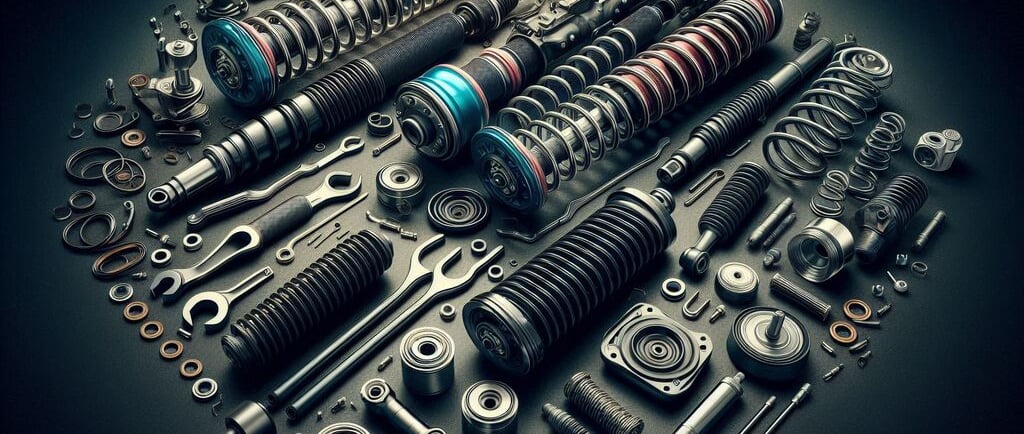Suspension Components: Includes shocks, struts, and springs for ride quality.
When it comes to your car’s performance and comfort, few things are as important as your suspension system.
CHASSIS AND FRAME PARTS
11/13/20244 min read


Suspension Components: Shocks, Struts, and Springs for a Smooth Ride
When it comes to your car’s performance and comfort, few things are as important as your suspension system. The suspension components—including shocks, struts, and springs—play a crucial role in ensuring a smooth and stable ride. In this article, we’ll dive into how these components work, why they’re essential, and how to keep them in good condition.
Why Suspension Components Matter
Your vehicle’s suspension system isn’t just about comfort; it’s key to safety and handling too. Suspension components absorb the bumps, dips, and potholes on the road, preventing the jarring forces from impacting your vehicle’s frame and occupants. Beyond comfort, a well-maintained suspension system also keeps your car stable, ensuring better handling and control.
Main Components of a Car Suspension System
There are several core elements to a car’s suspension system, but the most critical are shocks, struts, and springs. Each has a unique role, but together, they create a seamless experience that keeps you comfortable and secure on the road.
1. Shocks (Shock Absorbers)
Shock absorbers, or shocks, are responsible for dampening the up-and-down movement of the car’s springs. They prevent the vehicle from bouncing excessively, which would otherwise make for an uncomfortable and even dangerous ride.
How They Work: Shocks work by converting kinetic energy (the up-and-down motion) into heat energy, which is then dissipated. This conversion helps to stabilize the vehicle after hitting bumps, keeping your tires in contact with the road.
Signs of Worn Shocks:
Excessive bouncing after hitting a bump
Longer stopping distances
Leaking fluid around the shock area
If you notice these issues, it may be time to replace your shocks to restore a smoother, safer ride.
2. Struts
Struts are another critical suspension component, often combining the functionality of shocks and springs into a single unit. While not all vehicles have struts, they are common in many modern vehicles.
Function: Struts help support the vehicle’s weight, while also controlling the motion of the springs. They play an essential role in alignment, impacting the vehicle’s overall handling and steering precision.
Struts vs. Shocks: The main difference between struts and shocks is that struts support part of the vehicle’s weight, while shocks do not. Replacing struts can be more complex (and costly) than shocks because they often involve other components, such as the coil spring.
3. Springs
Springs are perhaps the most recognizable part of the suspension system, as they physically absorb the impact of the road. There are several types of springs, including coil springs, leaf springs, and torsion bars, each with unique applications based on vehicle type.
Purpose: Springs bear the weight of the vehicle and absorb road imperfections, ensuring a comfortable ride.
Types of Springs:
Coil Springs: Common in cars and small trucks, coil springs provide flexibility and durability.
Leaf Springs: Used mainly in trucks and SUVs, these are heavy-duty and support heavier loads.
Torsion Bars: Found in some off-road vehicles, torsion bars provide a rugged suspension option.
Springs generally last longer than shocks and struts, but they can still weaken or break over time, especially under heavy loads or rough driving conditions.
How Suspension Components Affect Ride Quality
Each of these components plays a role in ride quality and vehicle handling. When your shocks, struts, and springs are in top condition, you’ll experience:
Reduced Bouncing: Well-maintained shocks and springs dampen the vehicle’s movement, resulting in a more comfortable ride.
Improved Handling: Struts and springs work together to keep your car stable, allowing better control in turns and over rough terrain.
Enhanced Safety: With tires making consistent contact with the road, braking and maneuvering become more predictable, especially in emergencies.
If any of these components are worn or damaged, you may experience poor ride quality, reduced control, and even safety hazards.
Signs Your Suspension Needs Attention
It’s crucial to recognize the signs of suspension wear to avoid more extensive repairs. Here’s what to watch for:
Excessive Bouncing: If your car bounces excessively after hitting a bump, it’s likely time to check the shocks and struts.
Dipping and Diving: Your car may “nose dive” when braking, indicating weak shocks.
Uneven Tire Wear: Suspension issues can cause uneven pressure on your tires, leading to irregular wear.
Hard Turning and Poor Handling: If your car feels unstable when turning, it could be a sign that your struts or springs are worn.
Maintaining and Replacing Suspension Components
Routine maintenance is key to keeping your suspension system in optimal shape. Here are some tips:
1. Regular Inspections
Have your suspension components inspected annually, or every 12,000 miles. Look for leaks, rust, or worn bushings around your shocks and struts.
2. Replace Worn Parts Promptly
If you notice any of the signs mentioned, consider replacing your shocks, struts, or springs sooner rather than later. Worn suspension parts can lead to poor handling, tire wear, and potential safety issues.
3. Choose Quality Components
When replacing suspension parts, always opt for high-quality, durable components. This ensures longer life and better performance. A good rule of thumb is to replace shocks and struts in pairs for even wear and handling.
4. Consider Upgrades
If you want an extra-smooth ride or better handling for off-road adventures, consider upgrading to high-performance shocks or struts. Many aftermarket options can significantly improve ride quality and handling.
Conclusion: Don’t Ignore Your Suspension Components
Your vehicle’s suspension system, including the shocks, struts, and springs, plays a crucial role in ensuring a smooth, safe, and enjoyable ride. Regular maintenance and timely replacements can make all the difference in how your vehicle performs and feels on the road.



